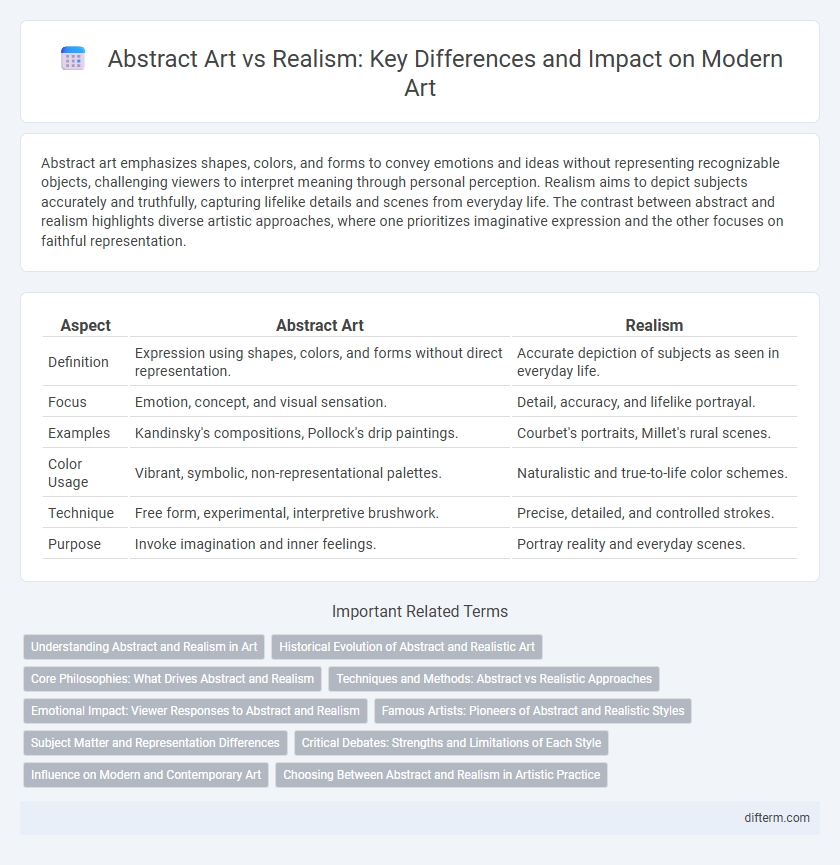Abstract art emphasizes shapes, colors, and forms to convey emotions and ideas without representing recognizable objects, challenging viewers to interpret meaning through personal perception. Realism aims to depict subjects accurately and truthfully, capturing lifelike details and scenes from everyday life. The contrast between abstract and realism highlights diverse artistic approaches, where one prioritizes imaginative expression and the other focuses on faithful representation.
Table of Comparison
| Aspect | Abstract Art | Realism |
|---|---|---|
| Definition | Expression using shapes, colors, and forms without direct representation. | Accurate depiction of subjects as seen in everyday life. |
| Focus | Emotion, concept, and visual sensation. | Detail, accuracy, and lifelike portrayal. |
| Examples | Kandinsky's compositions, Pollock's drip paintings. | Courbet's portraits, Millet's rural scenes. |
| Color Usage | Vibrant, symbolic, non-representational palettes. | Naturalistic and true-to-life color schemes. |
| Technique | Free form, experimental, interpretive brushwork. | Precise, detailed, and controlled strokes. |
| Purpose | Invoke imagination and inner feelings. | Portray reality and everyday scenes. |
Understanding Abstract and Realism in Art
Abstract art emphasizes shapes, colors, and forms to evoke emotions or ideas, often without representing real-world objects. Realism aims to depict subjects with accurate, detailed, and lifelike qualities, reflecting everyday scenes and natural environments. Understanding these styles involves recognizing abstract art's focus on interpretation and expression, contrasted with realism's commitment to precise representation.
Historical Evolution of Abstract and Realistic Art
Abstract art emerged in the early 20th century as artists like Wassily Kandinsky and Piet Mondrian broke away from traditional realistic representations, emphasizing color, shapes, and emotional expression over precise depiction. Realism, rooted in the mid-19th century with figures such as Gustave Courbet and Jean-Francois Millet, focused on depicting everyday life and social realities with accuracy and detail. The historical evolution of these styles reflects a shift from documenting the visible world to exploring internal perceptions and conceptual ideas.
Core Philosophies: What Drives Abstract and Realism
Abstract art prioritizes emotional expression and conceptual exploration, emphasizing color, form, and texture over representational accuracy, aiming to evoke subjective interpretation and inner experiences. Realism is grounded in the faithful depiction of everyday life and objective reality, focusing on detail, proportion, and perspective to convey the external world as truthfully as possible. The core philosophy of abstract art challenges traditional visual representation, while realism upholds a commitment to observable reality and precise imagery.
Techniques and Methods: Abstract vs Realistic Approaches
Abstract art employs techniques such as bold color fields, dynamic brushstrokes, and non-representational forms to evoke emotions and ideas without depicting recognizable subjects. Realistic art relies on precise techniques like detailed shading, perspective, and anatomical accuracy to faithfully represent visual reality. Both approaches utilize unique methods to convey meaning, with abstraction prioritizing conceptual expression and realism emphasizing visual fidelity.
Emotional Impact: Viewer Responses to Abstract and Realism
Abstract art evokes a spectrum of emotional responses through its non-representational forms, allowing viewers to interpret colors and shapes based on personal feelings. Realism engages audiences by depicting recognizable scenes with meticulous detail, fostering a connection through relatable narratives and lifelike emotions. Studies indicate that abstract art stimulates imagination and introspection, while realism tends to elicit empathy and a clearer emotional understanding.
Famous Artists: Pioneers of Abstract and Realistic Styles
Wassily Kandinsky pioneered abstract art by emphasizing color and form to evoke emotions without depicting recognizable objects. In contrast, Leonardo da Vinci epitomized realistic art through meticulous detail and lifelike representation, as seen in masterpieces like the Mona Lisa. Both artists significantly influenced their respective movements, shaping the evolution of art from literal depiction to abstract expression.
Subject Matter and Representation Differences
Abstract art emphasizes non-representational forms, colors, and shapes that evoke emotions or ideas without depicting concrete objects, whereas realism focuses on accurate, detailed representation of visible subjects from the natural world. In realism, subject matter includes everyday scenes, portraits, and landscapes rendered with lifelike precision, while abstract art often distorts or omits recognizable forms to highlight conceptual or aesthetic elements. This contrast in representation reveals differing artistic intentions: realism seeks faithful visual replication, whereas abstract art explores interpretation and internal experience.
Critical Debates: Strengths and Limitations of Each Style
Abstract art challenges traditional representation, emphasizing emotional expression and conceptual depth, yet it risks alienating viewers through its often ambiguous forms. Realism offers detailed, lifelike depictions that facilitate direct engagement and narrative clarity, but it may be critiqued for limiting artistic innovation by adhering to literal accuracy. Critical debates highlight how abstract art pushes creative boundaries while realism maintains cultural and historical documentation, each style balancing unique strengths and inherent limitations.
Influence on Modern and Contemporary Art
Abstract art revolutionized modern and contemporary art by emphasizing emotional expression and conceptual ideas over realistic representation, inspiring movements such as Expressionism and Minimalism. Realism provided a foundation for artists to explore social and political themes with detailed accuracy, influencing genres like Social Realism and Photorealism. The dynamic interplay between abstract abstraction and realistic depiction has driven innovative approaches, expanding the boundaries of visual storytelling in contemporary art.
Choosing Between Abstract and Realism in Artistic Practice
Choosing between abstract and realism in artistic practice involves considering the intended expression and audience engagement. Abstract art emphasizes emotional resonance and conceptual depth through non-representational forms, while realism prioritizes accurate depiction and detailed representation of subjects. Artists should evaluate their creative goals, technical skills, and the desired impact to determine which style aligns best with their vision.
Abstract vs Realism Infographic

 difterm.com
difterm.com